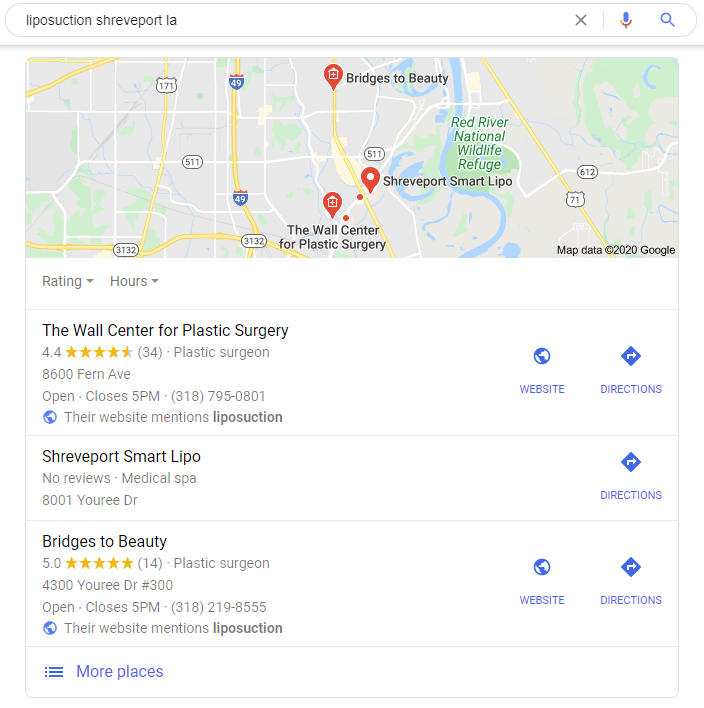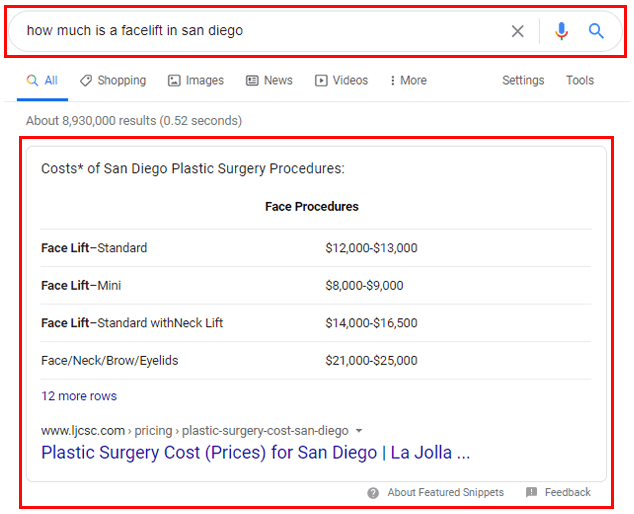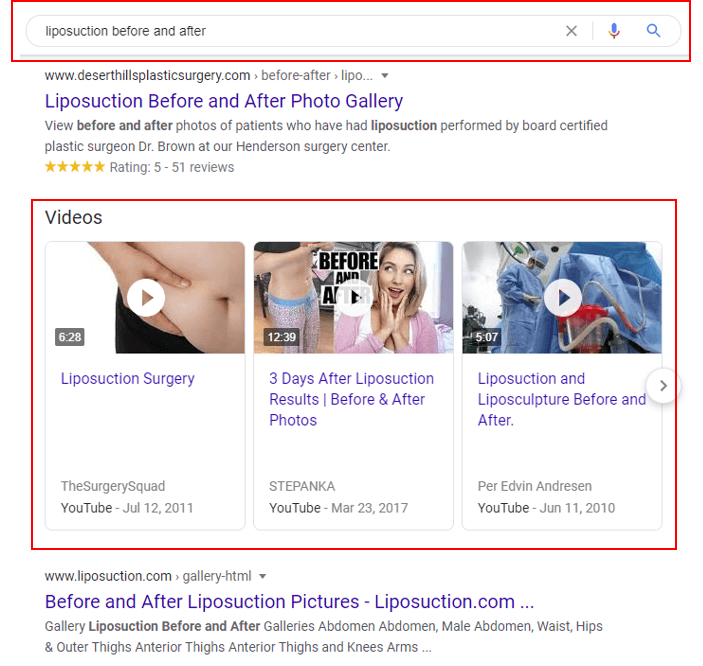Google rankings are a dog-eat-dog proposition. Rankings fluctuate widely over time, from week to week, day to day, hour to hour, and minute to minute. Just because you rank well in one moment is no guarantee that you’ll maintain that ranking position. Luckily, there are things you can do to increase your brand’s visibility in the search results. In this post, I’ll show you five ways to maximize your brand’s presence in the search results for the keywords you care the most about.
Let’s start at the top of the search engine results page (SERP) and work our way down.
1. Invest in PPC Advertising
Where’s this located on the SERP page?
Usually, PPC ads are at the top and bottom of the search results—sometimes, they’re in the Map Pack.
Why is it valuable?
Paid ads have an 11.38% CTR on Google (Sparktoro, 2019)
If you’re not ranking organically in a market, PPC is a great way to increase your brand’s visibility while you continue to work on organic rankings.
If you are ranking well, an investment in PPC can help you dominate the search results page. An effective PPC ad will:
- Get your brand seen in markets where you don’t have a physical location
- Drive additional traffic to your site
- Generate leads
So, invest in PPC. It sounds simple enough, but a solid PPC campaign that draws in consumers is no easy feat. One of the reasons this tactic is so effective is because of the ads’ location on the page. I’ll let you in on a little secret: the most clicks will happen at the top or the bottom of the page unless there are more attractive features present which draws the eye (more on that later).
2. Rank in Google’s Local Map Pack
Where’s this located on the SERP page?
Usually, the Google Local Map Pack is found directly under the first set of PPC ads. But Google often experiments with Map Pack placement, so it could be located at the top, middle, or bottom of the search results.
Why is it valuable?
The Map Pack is used most by mobile users, and mobile traffic is now higher (on average) than desktop traffic. Local traffic is some of the most valuable as these users are located where you are. If your brand can rank in the Map Pack and organically, you’ll take up more real estate in the search results.
Ranking locally is slightly different than ranking organically, and the algorithm, while similar, is a bit different. Some of the most important local ranking factors include:
- Proximity of the searcher to your business
- Relevance of the topic, question, or service
- Online reputation (especially Google reviews)
- Content optimization—are you including the locations in your copy, title, and structured data?
- Local citations from trusted online local directories
You must have a Google My Business profile listing your locations(s) to rank in the Map Pack. Bonus: doctors can have their own listings! This means that you could potentially take up two places in the map pack, one for your business and one for your doctor(s).
Here’s what the Map Pack looks like in the Google search results:

3. Have Your Content Showcased as a Featured Snippet
Where’s this located on the SERP page?
When a featured snippet is present, it’s generally located near the top of the search results, often above the Map Pack.
Why is it valuable?
Featured snippets are used to answer specific questions. In the aesthetics industry, it might feature something similar to the following:
Q: How much is breast augmentation surgery in Dallas?
A: Breast augmentation at our Dallas Forth Worth practice generally costs between $3,500 – $7,000 depending on the technique used, the type of implant, and whether or not the patient needs a breast lift.
Here’s what it looks like in the search results:

A featured snippet is a highly visible feature that stands out from the rest of the search results, and while it may generate fewer clicks to your site than other features, it can be a great way to build brand awareness. If I were to ask you who would you rather be featured—you or your competitor—I bet I know which you’d pick.
Google recently changed the rules for featured snippets: the page highlighted in the featured snippet cannot rank organically on the first page. So, you’ll want to use other pages like blog posts or supporting pages if you want to rank both in the featured snippet and organically—ideally having your priority procedure/service page ranking organically.
4. Rank Well Organically!
Where’s this located on the SERP page?
Organic rankings are usually located directly below the Map Pack. If a Map Pack isn’t present, then the organic results will usually be sandwiched between the PPC ads.
Why is it valuable?
75% of searchers never go past the first page of search results (HubSpot)
Ranking No. 1 for high-value keywords is the holy grail of search engine optimization (SEO) and can help spell success for your business. The good news is that you don’t technically have to pay to show up in the search results organically, so it can be a more affordable option than PPC. That’s not to say that you can simply sit back, do nothing, and expect to rank well. Here are some of the most important ranking factors:
- Well–written, relevant content that’s user friendly
- Quality links pointing to your site at both the domain level and the page level (backlinks)—previously, only DoFollow backlinks helped your rankings, but recently Google changed the way they view NoFollow links. Now, these links could be used as a hint as to how well Google thinks you should be ranking for a particular topic.
- Make sure that your technical SEO is on point. Some items included in technical SEO are:
-
- Canonicals
- Indexing
- Metadata
- Website structure & site map
- Page speed
- Mobile–friendly site
- Secure website
- URL structure
- Identify any error codes
- Internal links
-
- Research your market and your procedures or services to ensure your content is optimized for the best keywords. Use Google Search Console to identify opportunities to expand your content. If you’re getting a lot of impressions but few clicks for a particular keyword or category of keywords, it may be time to expand on that topic to drive more traffic to your site.
- Pay attention to your site’s usability – Google Analytics will help you pinpoint issues. Look for pages with high bounce rates and low time on the page; these pages might benefit from a refresh.
Organic keyword rankings, along with local, are some of the most valuable. They routinely provide quality traffic to your site that converts well.
5. Jump on The Carousel—Google’s Image or Video Carousel, That Is.
Where’s this located on the SERP page?
When present, the carousel is usually nestled in the organic results section, but it moves often, so don’t count on this staying put.
Here’s what it looks like in the search results:

Why is it valuable?
If you have images or videos in the carousel, then your brand content is being displayed in multiple formats. Images and videos are eye-catching, and you can leverage these assets to drive additional traffic to your site and increase your brand’s visibility!
Google prefers their toys, of course, so if you have videos, create a YouTube channel for your business and upload the videos. And make sure that you don’t skimp on the video descriptions!
For images, you’ll want to do a couple of things to get in the carousel (and improve your image-based rankings in general):
- It’s best if your image files include the keyword you want to rank for.
- Make sure that you have alt text attached to each image that succinctly explains the image.
- If your images are in your photo gallery, then make sure that each has a well-written description that includes relevant keywords and, possibly, your target location.
- Images are a great way to represent your brand. So, when possible, make sure that your images are branded with a watermark or a similar feature.
- For before-and-after photos, it’s best to stitch the images together.
- If an image is higher up on the page, it usually ranks better.
Wrapping Up!
There are many ways to make yourself more visible in the search results. The examples I’ve covered represent a sampling of the many search listing types that exist. It’s important to remember that Google is always changing the results and testing different features to deliver the most relevant results to users. This means that new opportunities will likely arise, and some listing features will be retired.
Keeping on top of the current features is crucial so that you know how to leverage your site’s content to increase your brand’s visibility. Anything you can do to increase your business’s brand footprint for your priority keywords will benefit you in the long run.
Do you need a strategic partner to help guide your online marketing efforts? Contact Etna today to start talking about how we can help you grow your business.


Leave a Comment